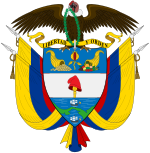United States of Colombia
You can help expand this article with text translated from the corresponding article in French. (June 2015) Click [show] for important translation instructions.
|
You can help expand this article with text translated from the corresponding article in Spanish. (June 2015) Click [show] for important translation instructions.
|
United States of Colombia Estados Unidos de Colombia | |||||||||
|---|---|---|---|---|---|---|---|---|---|
| 1863–1886 | |||||||||
 | |||||||||
| Capital | Bogotá | ||||||||
| Religion | Roman Catholic | ||||||||
| Government | Federal republic Dominant-party (1863 to 1880) | ||||||||
| President | |||||||||
• 1863-1864 | Tomás Cipriano de Mosquera (first) | ||||||||
• 1886 | José María Campo Serrano (last) | ||||||||
| History | |||||||||
• Established | 1863 | ||||||||
| 8 May 1863[1] | |||||||||
• Disestablished | 1886 | ||||||||
| Currency | Peso | ||||||||
| ISO 3166 code | CO | ||||||||
| |||||||||
| History of Colombia | ||||||||||||||||||||
|---|---|---|---|---|---|---|---|---|---|---|---|---|---|---|---|---|---|---|---|---|
 | ||||||||||||||||||||
| Timeline | ||||||||||||||||||||
|
||||||||||||||||||||
|
| ||||||||||||||||||||
The United States of Colombia (Spanish: Estados Unidos de Colombia) was the name adopted in 1861[2][3] through the Rionegro Constitution for the Granadine Confederation, following years of civil war. Colombia became a federal state itself composed of nine "sovereign states". It comprised the present-day nations of Colombia and Panama and parts of northwestern Brazil. After several more years of intermittent civil wars, it was replaced by the more centralist Republic of Colombia in 1886.
History
The civil war between 1860-1862 resulted in the dissolution of the Granadine Confederation which had been increasingly subjected to efforts by conservatives to centralize rule over the federal states. The liberal leader, General Tomás Cipriano de Mosquera, defeated the conservative government of President Bartolomé Calvo in 1862 and was installed as new leader. Much power was distributed back to the states from the government in Bogotá.
Colombian Constitution of 1863
On 3 February 1863, Congress approved the name United States of Colombia for the country,[citation needed] and on 8 May, the Rionegro Constitution was promulgated. It established a federal system with a central presidency[citation needed] with a term of two years and without the possibility of immediate re-election. The president was elected by the states. On 12 May, Mosquera was chosen to be the first president. Under this decentralized regime, regionalist feelings reached their ultimate expression[citation needed]
Following the reforms of earlier years, before the creation of the new federation, the liberals aimed to build the United States of Colombia upon a decentralized, free market system. As with previous liberal presidencies, such as Mosquera's first two terms as president, a tough stance towards the Catholic Church was taken, much to the dismay of conservatives. Land held by the Church was seized and transferred to industrialists and the influence and rights of the Church was severely limited.
In 1871, the drive for modernization and economic reform led to the Colombian peso being pegged to the French franc as part of the international gold standard.
Abolition
After several years of intermittent civil wars, in 1886 the Colombian Conservative Party led by President Rafael Núñez proclaimed a new constitution of centralist character that abolished the United States of Colombia and created the Republic of Colombia. The conservatives immediately withdrew Colombia from the gold standard and the subsequent increase of printed currency led to troubling inflation levels.
Meanwhile, the new state would continue to be plagued by conflict between liberal and conservative factions, which eventually would lead to the secession of Panama in 1903.
States
The nine original states that formed the confederation were:
- Antioquia State,
- Bolívar State,
- Boyacá State,
- Cauca State,
- Cundinamarca State,
- Magdalena State,
- Panamá State,
- Santander State and
- Tolima State,
and the territories were:
References
- ^ Constitutional history of Colombia#The constitution of 1863 - United States of Colombia
- ^ http://www.1911encyclopedia.org/Colombia Retrieved 29 December 2010.
- ^ http://www.historyfiles.co.uk/KingListsAmericas/SouthColombia.htm Retrieved 29 December 2010.


